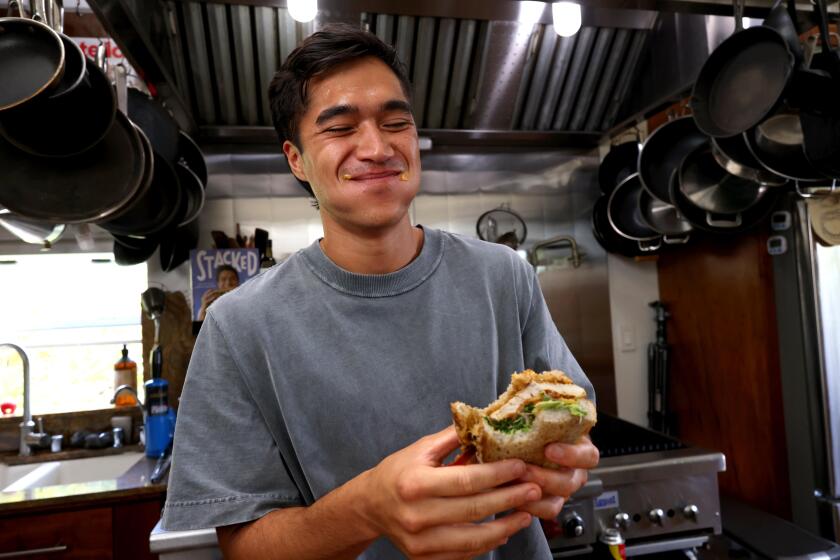Where Mashed Potatoes and Gravy Are Foreign Cuisine
The stretch of the San Gabriel Valley from Monterey Park to Rowland Heights is a sort of Silk Road to glorious Chinese food, well known to food fetishists from as far as Taipei, New York and the Westside.
But a surprising new hot spot is packing in the Asian immigrants who started the valleyâs culinary revolution.
Itâs the Temple City branch of the Hometown Buffet chain.
In an area where one can feast on ducks roasted by experts from Beijing, dim sum rivaling Hong Kongâs, or fare as finely tuned as Chinese Islamic, locals crowd this cavernous eatery to wolf down limitless servings of liver and onions and mashed potatoes with brown gravy.
The throngs at Hometown Buffet reveal a side of immigrant life missed by outsiders bewildered by the non-English signs lining the valleyâs boulevards: While immigrants have remade the area, the area is also remaking them.
Thus, just around the corner from places where Hong Kong-trained chefs serve lobsters bathed in brandy to astute gourmets, many immigrant families choose to spend their nights out at Hometown, where steam trays full of mushy melanges are crowned with crushed potato chips.
Itâs exotic stuff for folks whose everyday diet might include liberal doses of noodles, oyster sauce, garlic and chili peppers. Hometown Buffetâs beef patties and au gratin potatoes are a break from their routine.
âItâs different, a change of taste for us,â said James Ma, 41, an Alhambra resident who came to the United States from Taiwan 16 years ago. âWe always eat Chinese food at home. Sometimes you can just eat too much Chinese food.â
*
On a good day, more than 2,000 customers will put up $5.59 for lunch or $7.39 to pile their plates high at the all-you-can-eat dinner buffet. According to general manager Scott Hurst, the average weekly total of about 12,500 customers makes the Temple City branch among the busiest of the 350-restaurant chain.
Weekend nights bring lines overflowing from Hometown Buffetâs entrance into its shared strip mall parking lot.
Once inside the restaurant--stuck between an Office Depot and a Fabric City--families while away the hourlong wait in an entryway adorned with Norman Rockwell prints and copies of old Saturday Evening Post covers.
Parents admonish young children to be patient, using seemingly every language from Mandarin and Teo Chew to Hindi, Arabic and Spanish and even an occasional Germanic tongue.
Kids keep up the complex balancing act well known in immigrant families, complaining to their parents in one language, while bickering with siblings in English.
Manager Hurst estimates that more than half of the restaurantâs customers are Asian immigrants. Latino immigrants are another large group, and longtime area residents--themselves a diverse lot--round out the mix.
The San Gabriel Valley has continuously drawn immigrants since Spaniards founded the San Gabriel mission 225 years ago.
In this century, Temple City and nearby towns such as Monterey Park and Alhambra have been places that served as the higher rungs for those moving up Americaâs social ladder.
Those who moved from farms or the Dust Bowl to high-wage manufacturing jobs were among the early homeowners in the sprawling tracts.
A large wave of Italian immigrants joined them, as did Japanese Americans returning from World War II internment camps and longtime Latino residents moving out of their ethnic enclaves.
Some of the interracial, three-generation families at the restaurant on Friday nights or after church on Sundays are living displays of those eras.
Today, the new arrivals hail from places like Taiwan, China, Mexico and Southeast Asia. For many of them, the area is still a foothold of middle-class respectability, a place to buy a house after years of hard work and saving.
John Kwan, a third-generation Chinese American who was eating at Hometown with some friends from his ski club, said he thinks the buffetâs vast offerings are partly responsible for the restaurantâs success with immigrants because neophytes can sample an array of dishes in one place, for one price.
âTheyâve got the whole variety of white manâs food here--hamburger, salads, Italian, fish,â he said.
Also on the table were white interpretations of Asian foods: teriyaki chicken wings, fried rice and egg foo yong.
Now, I was born and raised in an Asian American neighborhood and am married to someone from Taiwan, and I have no idea what egg foo yong is. But when I saw it listed on Hometown Buffetâs menu I thought I might finally find out.
Eyeing some round egg-derived discs floating in gravy, I wondered if my quest might be over. An Asian man in front of me was ladling three of them onto his plate.
âIs that egg foo yong ?â I asked.
âI donât know what is egg foo yongâ he replied in heavily accented English.
*
The fear that immigrants will never give up their home-country ways is commonly expressed these days, in everything from the push for English-only laws to movies like Ridley Scottâs still-popular film âBlade Runner,â which portrayed a future Los Angeles transformed into a dark, frightening slum of Asians and Latinos.
Yet todayâs immigrants have much in common with the types of folks whose images are captured in the Norman Rockwell prints on Hometown Buffetâs walls. About 60% of Latino and Asian immigrants in the Los Angeles region live in traditional two-parent families, compared with about a third of whites, according to U.S. Census Bureau data.
In places like Hometown Buffet itâs clear that immigrants today arenât plotting to colonize America, but like those before them are simply after a piece of the pie, which still happens to be apple.
More to Read
Eat your way across L.A.
Get our weekly Tasting Notes newsletter for reviews, news and more.
You may occasionally receive promotional content from the Los Angeles Times.










